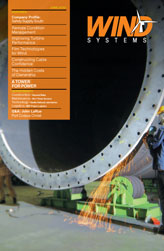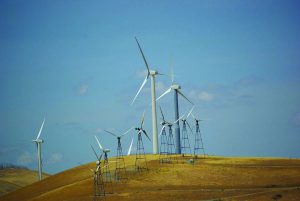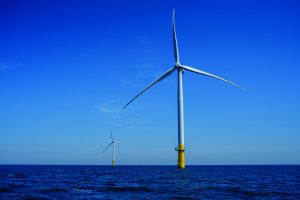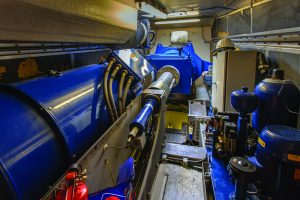The Moventas CMaS (condition management system) is a remote monitoring system for wind turbine gears. It recognizes possible damages in gears and other mechanical components in advance, even before they start to interfere with the turbine operations. The system consists of different sensors and the main unit, which collects and processes the measured data. The measured data is then transferred to a server, where it will be analyzed in greater depth.
From Monitoring to Management
There are several products on the market that focus on gear condition monitoring. CMaS enables a broader review of the whole entity, embracing the preventive condition management approach. A significant portion of the system was developed by a Moventas R&D team, which allows us to offer very competitive pricing.
Wind turbine gears are exposed to extreme changes, both in terms of load and environmental circumstances. No wonder that the gear is one of the most sensitive components in the turbine, and that monitoring its condition is so welcome. Traditional products focus mainly on measuring vibrations from rotating components. CmaS, on the other hand, is based on a profound understanding of the malfunctioning process of gears. In addition to vibration CMaS monitors a variety of different quantities, especially the physical and chemical qualities of oil, oil wear particles and pressure, revolutions per minute, torque, and temperature. Figure 1
Early changes are visible in oil lubrication properties long before they can be measured in vibration. If those changes are not addressed they generate metal contacts and abrasion, and after a single year they may cause a serious damage that requires thorough service and new components.
For end users, planned and anticipated service breaks are by far a better solution than repairing the damage. During the warranty period OEMs may have to pay for downtime hours. Even at the quickest an unforeseeable reparation in the turbine can take two weeks, which means paying out a great deal of money just for lost production, not including the service work with associated costs. If the damage has to be repaired at the workshop, a lead time of several weeks can be expected. CMaS has a short return of investment time. CMaS itself can be installed to new and old gears alike.
Expert Analysis
The data CMaS produces is analyzed by remote diagnostics experts at Moventas service locations, but customers also have access to the CMaS net service, even with mobile connection if necessary. This access includes all measured data from their turbines. Moventas currently has a team consisting of engineers with a long history and experience analyzing powertrain phenomenons.
Although traffic light warnings from turbines can be sent directly to customers if desired, the traditional way to operate with CMaS involves all warnings being handled and analyzed by Moventas specialists. All generated reports—along with conclusions and recommendations—are then provided to the customer. This is the preferred method, since Moventas can best serve its customers by sharing its expertise with its clients. This type of cooperative model guarantees the shortest response time for onsite service and the shortest lead time for factory services, and it also helps in planning maintenance actions and spare part inventories.
CMaS is developed to monitor a large number of wind turbine gears very effectively by using sophisticated analyzing methods, algorithims, and intelligent sensors. These sensors are used especially for vibration monitoring, and also in some cases intelligent oil particles and oil condition monitoring are used. By using intelligent sensors CMaS is exceptionally scalable, and the analysis provided by intelligent sensors is a key issue for the effective monitoring of large numbers of turbines.
Intelligent Digital Sensor
Moventas has already been using intelligent vibration sensors for five years in serial production. The development of an intelligent vibration sensor began about seven years ago, when the first prototypes of intelligent vibration sensor were made.
Based on the prototype testing period in 2003, Moventas decided to move its first-generation vibration sensor, the VIB-100, into serial production. Production of the VIB-100 sensor lasted from 2005 through 2010. During this period Moventas monitored the behavior of these intelligent vibration sensors, and in 2007 design of the second-generation sensor, the IVS-20, began. The IVS-20 is based on VIB-100 technology. IVS-20 prototypes were ready in early 2009, and during that year prototype tests were conducted. At the beginning of 2010, the IVS-20 was moved into serial production.
Traditional vibration sensors measure data passively, and the signal is transferred to main unit as a charge signal. The main unit then conducts signal processing, calculations, and analyses. In an intelligent vibration sensor the measurements, processing, calculations, and analyses are conducted inside the sensor. This means that signals don’t have to be transferred long distances to the main unit, which provides a very high-quality signal.
When the sensor has processed and analyzed the data, it is then transferred to the CMaS main unit. Data transfer is conducted over a field bus. This means that in a normal operation mode only key figures/parameters are transferred. Spectrum and time domain data is also transferred regularly, but daily analyses are based on monitoring key figures. When something outside of the normal occurs, more-detailed data/raw signals are transferred. An important point is to successfully transfer key figures without losing any information. When daily monitoring is based on the analysis of key figures, monitoring is extremely cost effective.
The IVS-20 is an intelligent vibration sensor that measures in three dimensions. It has an inner calculation power of 500 MHz, which is a great advantage in many situations. Moventas has integrated many signal processing algorithms within the unit, and it uses traditional methods such FFT and envelope. The IVS-20 also has many other algorithms, such as:
• RPM scalable follow-up frequencies; fixed follow-up frequencies;
• crest factor;
• time domain peak detection;
• vibration severity;
• optimized detailed vibration severity.
In addition, IVS-20 software can be updated remotely. For example, the Moventas analyzing and CMaS R&D teams are currently designing new highly effective vibration analyzing algorithms. These new software algorithms can be updated to IVS-20 online, even when CMaS is already installed in a turbine.
Sensor Scalability
Another important feature is scalability. With intelligent sensors, the main unit doesn’t need powerful signal processing power, and the cost of the main unit is quite reasonable. This is very important in cases where only a couple of vibration sensors are installed, since CMaS doesn’t cost extra for unused calculating power. The intelligent sensor has its own digital signal processor (DSP) as well. For instance, the IVS-20 has DSP with a calculation power of 500 MHz, which is nearly as much as that found in a smaller laptop computer. When it comes to signal processing power, it’s even possible to calculate 524288 points FFT. This is just another example of the many features built into this efficient, accurate, and economic unit.



































